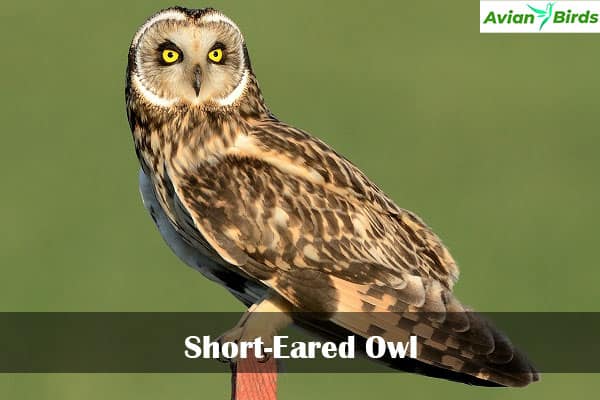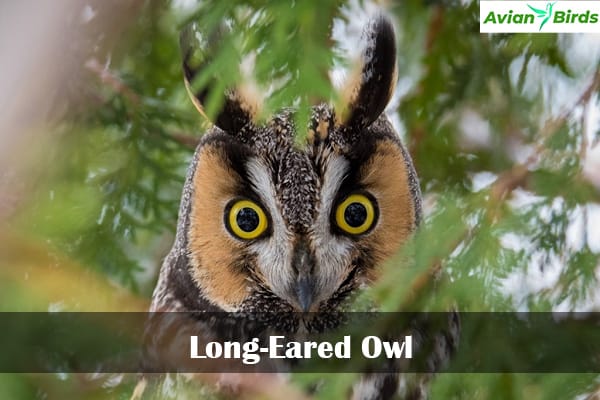7 Owls in Alabama (ID Guide With Pictures)
Owls in Alabama captivate with their silent flight and piercing eyes. I’ve researched these stealthy hunters, from the Barred to the Great Horned. They thrive in Alabama’s varied landscapes, from urban sprawls to hidden forests. Also, These owls are ecosystem champions, yet remain shrouded in mystery. Flow me in uncovering their secrets, from quirky behaviors to conservation challenges.
Here we’ll learn about 7 different types of Owls In Alabama!
1. Eastern Screech-Owl
- Scientific name: Megascops asio
- Life Expectancy: 8 to 10 years
- Size: 16 to 25 centimeters (6.5 to 10 inches)
- Weight: 121 to 244 grams (4.25 to 8.5 ounces)
- Wingspan: 46 to 61 centimeters (18 to 24 inches)
- Conservation Status: Least Concern
The Eastern screech owl is a cool bird that lives all over eastern North America, even where people are. It comes in two colors: red down south and grey up north, to match the trees where it lives. These owls usually live alone, but in April, they find a mate and stick together.

They don’t build nests; they use holes in trees. They eat lots of different things, like small animals, bugs, and sometimes fruit. Also, They hunt at night using their great hearing. They’re not in danger of disappearing, but we have to be careful not to mess up their homes or food.
2. Great Horned Owl
- Scientific name: Bubo virginianus
- Life Span: 25 to 50 years
- Size: 17 to 25 inches long
- Weight: 2.64 to 3.52 pounds
- Wingspan: 3 to 5 feet
- Status: Least Concern
The Great Horned Owl is a master of survival, living everywhere from deserts to cities, even down to Brazil. At night, they blend in with their speckled feathers, and those cool “horns” might even help them talk to other birds. They’re early birds when it comes to nesting, starting in January, and they’re not picky about where they live—they’ll crash in old nests from other birds.

In Alabama, they munch on small critters like voles and rabbits, but they’re not fussy eaters and will go for birds or bugs too. Sadly, people have been tough on these owls, and their numbers have dropped. We’ve got to be careful because our actions can mess things up for them.
3. American Barn Owl
- Scientific name: Tyto furcata
- Life Span: 10 years
- Size: 13 to 15 inches in length
- Weight: 0.88 to 1.3 pounds
- Wingspan: 11 to 14 inches
- Status: Least Concern
The American Barn Owl is a ghostly beauty, part of a group with Western and Eastern kin. It’s a night hunter, hiding by day in tree nooks. Plus, Come spring to summer, it pairs up for life, the male wooing with flight and finding a cozy nest spot.

In Alabama, These owls feast on small mammals, using their unmatched hearing to hunt in the dark. Though not endangered, it face threats from our pesticides, yet these owls are fighters, bouncing back with time.
4. Barred Owl in Alabama
- Scientific name: Strix varia
- Life Span: 8 years
- Size: 15 to 25 inches long
- Weight: 1.34 to 2.54 pounds
- Wingspan: 38 to 49 inches
- Status: Least Concern
Barred Owls, with their cozy 6-mile range, are a common sight in eastern North America. Sporting brownish-grey feathers with dark stripes, they’re a monogamous bunch, pairing up in February’s courtship dance. They’re not builders; they prefer tree-trunk homes in dense woods.

Their menu? Mostly small mammals, but they’ll dine on anything from birds to bugs, and even the odd rabbit or squirrel. With a strong 3 million count, they’re doing okay, but we’ve got to watch out for their forest homes and keep their dinners clean.
5. Short-eared Owl
- Scientific name: Asio flammeus
- Life Span: 12 years
- Size: 13 to 17 inches long
- Weight: 7.3 to 16.8 ounces
- Wingspan: 33 to 43 inches
- Status: Least Concern
The Short-Eared Owl stands out in the owl world, not just for its speckled brown feathers and striking wing bars, but for its unusual daytime hunting. These owls are social during the breeding season in March, nesting on the ground in open spaces like meadows.

Also, They eat a variety of prey, from voles to sparrows. Sadly, their numbers are falling due to habitat loss and accidents. Yet, they’re adapting and spreading, keeping them out of the endangered zone for now.
6. Long-eared Owls in Alabama
- Scientific name: Asio otus
- Life Span: 10 to 27 years
- Size: 12 to 16 inches long
- Weight: 5.6 to 15.3 ounces
- Wingspan: 2 feet 10 inches to 3 feet 4 inches
- Status: Least Concern
The Long-eared Owl is a master of disguise, with feathers that mimic pine trees. It’s a common sight worldwide, known for its eerie calls that echo through forests. These owls don’t build nests; they take over old ones or find tree cavities.

In Alabama, they hunt small mammals and other critters, waiting quietly or flying low to pounce. Sadly, their numbers are dropping due to habitat loss and accidents, but they’re still widespread and not endangered. Their ability to blend in and haunting calls make them unforgettable forest dwellers.
7. Northern Saw-whet Owl
- Scientific name: Aegolius acadicus
- Life span: 7 to 17 years
- Size: 6.7 to 8.7 inches long
- Weight: 1.9 to 5.3 ounces
- Wingspan: 16.5 to 22.2 inches
- Status: Least Concern
The Northern Saw-Whet Owl is a tiny, elusive bird found all over North America, including Alabama. It’s got a cute round face with cream and brown streaks, a sharp beak, and bright yellow eyes. Its call sounds like a saw being sharpened, which is pretty cool.

These owls pair up in March, but sometimes males have more than one partner. They nest in holes made by woodpeckers or in boxes we put up. They eat small animals and insects, and they’re really good at catching them with their sharp claws and beaks.
Even though we see them a lot, they have to deal with losing their homes and fighting for nesting spots. But for now, they’re not in danger of disappearing.
Check Our Previous Articles:
Spots of Alabama Owls
Exploring Alabama’s nature preserves is a fantastic way to spot owls. Wheeler National Wildlife Refuge is great for seeing Great Horned and Barred Owls, while Bon Secour National Wildlife Refuge is the place for Eastern screech owls. For a glimpse of the Northern Saw-whet Owl, try Sipsey Wilderness, and Cheaha Wilderness is perfect for Barred Owls.
You can hike or join a birdwatching tour to learn more. Remember, these wild owls need their space, so keep a respectful distance and enjoy the wonder of their presence.
Frequently Asked Questions
Q1. What are the most common owls in Alabama?
The Eastern Screech Owl is the most common in Alabama.
Q2. Are owls protected in Alabama?
Yes, owls are protected under state and federal laws in Alabama.
Q4. Where do most owls live in the US?
Owls are found throughout the United States, inhabiting diverse environments such as forests, grasslands, deserts, and urban areas.
Q4. What is the biggest owl?
The Eurasian Eagle Owl holds the title of the largest owl species in the world.







